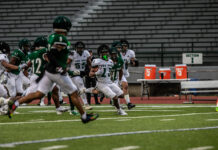More than 200 lawsuits are reportedly being filed against the National Collegiate Athletic Association (NCAA) for its handling of concussion-related injuries in college football, according to an article published by Sports Illustrated on Feb. 1.
A December 2015 study by the Centers for Disease Control and Prevention found that concussions result in 52,802 (5 percent) of all injuries sustained in college athletics.
Scott Morrison, Slippery Rock University’s head football and tennis trainer, said it’s tough to say whether the NCAA, universities as a whole or individual student-athletes are to blame for how concussions are managed and treated.
“Universities and the NCAA share some responsibility in these cases but a lot of it does come down to the athlete,” Morrison said. “If they are not going to do what you tell them to do to keep them safe, then where is that responsibility? Everybody, including the NCAA, could be doing what they’re supposed to be doing, but if the athlete isn’t, then the university, or even the NCAA, shouldn’t have to be paying for that.”
Within the past five years, 166 concussions across all 17 of SRU’s NCAA Division II sports have been documented by the university’s athletic training personnel, Morrison reported. Of those concussions, 17.5 percent (29) have occurred in football, he said.
According to SRU’s concussion management plan, athletic trainers look to identify concussions based off four broad symptom categories: physical, cognitive, emotional, and sleep. The plan, which was updated in July 2017, and consists of information published in 2013 by the American Medical Society, states that official diagnosis of a sport-related concussion is a clinical diagnosis based on a decision from the athlete’s health care providers.
Morrison, who graduated from Pennsylvania State University with a degree in kinesiology, said SRU bases its concussion management plan on the NCAA’s guidelines.
“The NCAA doesn’t necessarily mandate the policy that they send out,” Morrison explained. “They more or so provide a guideline, or framework, for what Slippery Rock is to follow, and leave it up to individual institutions to determine what needs to be done. How we see it, [the NCAA] gives out the bare minimum, and then we take it a little bit further to be a little bit more detailed to protect our student-athletes.”
According to a 2015 study from the American Physical Therapy Association, wrestling is the primary collegiate sport where most concussions are sustained, averaging 10.92 per 10,000 athletes annually. Men’s and women’s ice hockey followed, with 7.91 and 7.52 concussions, respectively. College football reported 6.71 concussions per 3,417 exposures, which ranks them as the sport that overall produced the most annual concussions.
Morrison, in the midst of his fourth year at SRU, said concussions are tricky, because of the lack of clear visual signals that can be seen.
“If you injure your leg, I can see that,” he said. “I have to rely on the athlete to be honest with me with what they are experiencing, which doesn’t always happen. If, from the sidelines, we see somebody get absolutely lit up and really get rocked, we are going to pull that athlete to the side and have a conversation with them, and try to get a sense of if they are being honest with us.”
Morrison said that if he and fellow trainers begin to notice an athlete is coming off as dizzy, or reports a headache, then they will begin to conduct a Sport Concussion Assessment Tool (SCAT 5) test on them. According to the British Journal of Sports Medicine (BJSM), a SCAT 5 test is designed for athletes 13 years of age or older, and is the go-to on-field test for concussions. It cannot be properly performed in less than 10 minutes, and involves a five-step process when performed on field. If the athlete successfully passes with the clearance of a medical professional, then he or she is allowed back in the game, Morrison explained.
“If the athlete fails any portion of that test, then we immediately shut them down until they see a doctor,” Morrison said. “We’ll give that athlete, and possibly their families, information on what they need to do to get treated. At that point, we set them up with doctor’s appointments, and will probably even conduct a neurocognitive computer-based test for them as well.”
Morrison said the athlete is then turned over to a doctor to perform the necessary treatment to get that athlete healthy and back on the field. Morrison highlighted that many people have false stigmas about the after effects of concussions.
“A lot of times, especially in football, you see medical professionals say that if an athlete gets lit up on the field and then complains about a headache, then you have to shut them down,” he said. “Come Sunday morning, everybody, including myself, has a headache. I don’t necessarily think that headaches are a great diagnostic tool for concussions and I think the literature surrounding the topic is supporting that.”
SRU head football coach Shawn Lutz said last season that following week six’s 30-27 win against Indiana University (Pa.), his team stopped going full contact during the week’s practices.
“We really tried to preserve our team because we wanted to remain healthy for the playoff push we were making,” Lutz explained. “All injuries must be taken seriously, but a lot of the times we know the timetable for specific injuries. With concussions, you can never know how long an athlete could be out for, so we really tried to limit in-practice contact.”
Morrison said the steps taken by Lutz were important but that if it were up to him, there would be no full-contact in practice during the regular season except for training camp, in August.
“From a concussion standpoint, yes, it is crucial to not go full contact during practice,” Morrison said. “But even from a performance standpoint, it just keeps us fresher out on the field.”
Morrison said the majority of concussions sustained during the 2016 and 2017 football seasons occurred during full-contact practices. The program has eliminated a lot of that full-contact during practices and, as a team, the number of concussions sustained during a season have gone down from about four to five each year to about one to two, Morrison explained. Morrison said he has yet to find some kind of trend when it comes to concussions.
“This past season, we had about two concussions during the entire schedule,” he said. “In other years, those numbers have gone up to about four or five a season. It’s not really the epidemic that the media makes it out to be.”
Despite the numbers, Morrison reports from past seasons, he said there’s still an issue with athletes not reporting their concussion-like symptoms, because they don’t want to see a decrease in playing time.
“There are probably a lot more players, across all sports, not just football, that do not report symptoms, which is really alarming from an athletic trainer’s standpoint,” Morrison said.
Morrison said the athletic training department, as a whole, is clamoring to find a device that can show promise in treating concussion. One in particular that showed promise to Morrison and his team was the Vestibular Ocular Motor Screening tool (VOMS).
“The training to get certified to use VOMS is not that rigorous, but it takes some time,” Morrison said. “And you have to put in that time to get good at it, so it’s not that reliable.”
Morrison said that from what he’s seen, the best and easiest way to really tell if an athlete has a concussion is if they pull themselves out of the game.
“Once they reach out to with you concern, they are done; we shut them down for the remainder of the game or practice,” Morrison said.
To be cleared to resume contact, Morrison said the athlete has to be cleared by both himself and the team’s independent medical physician, Dr. Megan Miller.
“I am in touch with [Miller] and the team’s orthopedic surgeon on a pretty regular basis,” Morrison said. “We have a pretty good working relationship and communicate with each other. She never tries to pull rank on me and I don’t try to bully her on stuff; we just try to have a professional discussion with each other so that we can protect and treat our student-athletes.”
Morrison said on average, when an athlete is diagnosed with a concussion, he or she is typically out for 10 days. There are a number of factors, particularly a certain athlete’s medical history, Morrison said.
“I have seen people come back in as little as 48 hours, depending on how well they handle their treatment options,” Morrison explained.
Martin Donahue, head trainer for SRU’s women’s soccer and softball teams, believes there’s no average recovery time.
“The shortest recovery team for an athlete is probably going to be five days,” Donahue said. “And that’s because of the length it takes for medical clearances to go through and be confirmed.”
Donahue said there’s no correlation between the impact of the concussion and the timetable that the athlete might be out for.
“I have had athletes that have been unconscious at the time of the injury and end up being fine a day or two later,” Donahue said. “And there have been times that an athlete has been involved in a small-time impact, where we aren’t sure if they have a concussion right away, and then they have symptoms for months.”
Mark Sappington, an SRU women’s soccer assistant coach, said the NCAA is not really to blame for the recent lawsuits in the news, because it’s not up to them to babysit athletes.
“College athletes know the risks of playing high-intensity sports,” Sappington said. “If they suffer a questionable head injury, they should be responsible and know the risks of going back out on the field too soon.”









